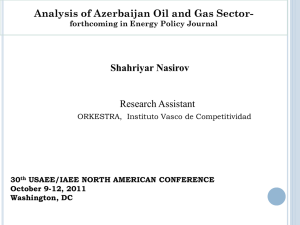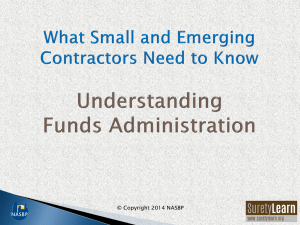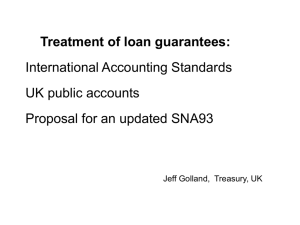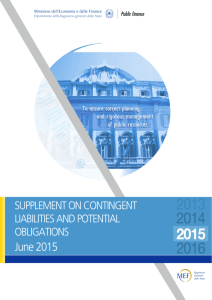Bank Guarantees and Indemnities
advertisement
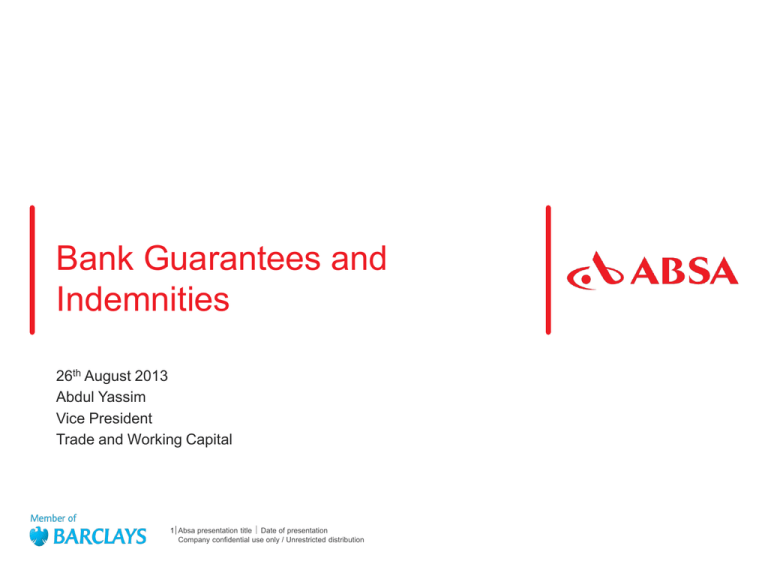
Bank Guarantees and Indemnities 26th August 2013 Abdul Yassim Vice President Trade and Working Capital 1 Absa presentation title Date of presentation Company confidential use only / Unrestricted distribution Agenda • Current Environment • Types of Guarantees • Challenges • Structured Solutions 2 Absa presentation title Date of presentation Company confidential use only / Unrestricted distribution Government infrastructure budget Strong Infrastructure MTEF investment ... ... with a strong focus on Energy and Rail R844.5bn MTEF Previous year R284.5bn R297.6bn R262.2bn R226.7bn 71 76 Transport and logistics 31% Water and sanitation 9% 64 56 25 25 89 92 26 22 81 Infrastructure services 25% 75 73 2011/12 92 100 104 2012/13 2013/14 2014/15 Energy Transport and logistics Water and sanitation Infrastructure services Energy 35% Increased MTEF infrastructure investment of R845bn over the medium term with pipeline/order book of projects worth R1.2trillion planned by the Presidential Infrastructure Coordinating Commission (PICC) could steer towards stronger economic growth for SA. There is clear infrastructure investment towards lagging infrastructure such as Energy, Transport (Roads) and Water. Concerns remain on the lack of capacity to effectively spend allocated infrastructure budgets. The Construction Industry Development Board (CIDB) has been mandated to improve the monitoring of government’s expenditure and management of infrastructure projects and programmes. Proactive bank solutioning for construction companies is vital – to ensure effective and sustainable relationships in the market 3 Source: National Treasury Typical IPP Project Structure Equity and Debt Balance of Plant Supplier EPC Contract Project SPV EPC Contractor OEM Agreement OEM Provider Off taker 4 Corporate Structure Balance of Plant Supplier Subcontracting Agreement Solar Equipment supplier EPC Contract Corporate O&M Agreement OEM Provider 5 Current Environment Project owners often demand performance guarantees of about 10% of project value from contractors. Project owner EPC Contractors Financial needs Contractor • • • • • Bank provides contractor performance guarantee based on equivalent collateral 6 Guarantees Working Capital Supplier Finance Transactional Insurance Types of Bank Guarantees Bid Guarantees Advance Payment Guarantees Performance Guarantees Retention/Warranty Guarantees Standby Letters of Credit 7 Bid Bond/Tender Guarantee • Issued at the initial stage of a contract. • The purpose of this unconditional commitment by the bank is to ensure that the party to whom a contract is ultimately awarded will indeed accept the award and proceed with the execution of either the construction or supply or delivery obligation falling under the contract. • The beneficiary (employer) can claim against the Bid Bond by making a simple statement that the contractor has not accepted the award. 8 Advance Payment Guarantee • In large contracts, the contractors normally take mobilization advances from the employers to commence work on projects. • To safeguard the employer, the contractor arranges for its bank to make a commitment to return to the employer the advance taken by the contractor if it fails to proceed with the project. • This commitment is unconditional on the part of the bank. 9 Performance Guarantee • Normally, once a Bid is accepted, the Bid Bond is replaced by a Performance Guarantee for nearly 10% of the value of the project. • This guarantee assures the employer / beneficiary of the creditworthiness of the contractor or supplier, provides access to funds for the employer to minimize damages in case the contractor fails to deliver, and acts as a tool for leverage against the contractor to ensure due and diligent execution of the contract. • Such guarantees are payable against a simple claim from the employer stating that the contractor has not fulfilled its commitment. 10 Retention/Warranty Guarantees • In most construction projects, by agreement a part of the progress payments (against running bills of the Contractor) is retained by the Project Owner to cover any faults that may subsequently show up in the work performed. • Such retained amounts may, however, be released against a bank guarantee. • The guarantee is payable against a simple claim from the beneficiary stating that the contractor has not fulfilled his commitment. 11 Standby Letters of Credit • A commitment issued by the bank to other banks / 3rd parties committing on behalf of its customers to pay a fixed sum of money in case the customer fails to fulfill its financial commitment. • The Standby Letter of Credit is normally issued in respect of transactions payable under open account. • Claims are honored against a written declaration from the supplier, confirming delivery of the goods or services and non performance by the buyer. 12 Challenges Project owner requirements: • Prefer performance guarantees from banks • Looking for performance guarantees typically between 10% to 20% of project value • Tenors on performance guarantees range from between 1 year to 5 years depending on the project. Concerns with project owner requirements: • Create financial strain as facilities are often collateralized. 13 Sub Participation Solution • Bilateral facility agreed between applicant and Absa • Absa is the sole issuer of the bond and executes risk participation agreements with a group of surety companies. • Although the risk participations are typically disclosed to the applicant, participants have no direct contractual relationship with the applicant. Company confidential Sub Participation Structure Surety Co EPC Contractor Facility documents Surety Co Participation Agmt Absa Surety Co Beneficiary Bonds/Guarantees Participation Agmt Surety Co 15




